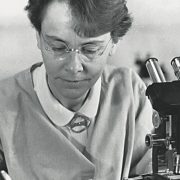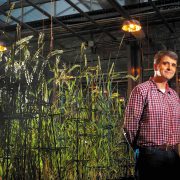Plant Scientist Highlight: Maria Harrison
 Why did you originally decide to pursue science and what got you interested particularly in arbuscular mycorrhizal fungi?
Why did you originally decide to pursue science and what got you interested particularly in arbuscular mycorrhizal fungi?
I was always interested in science – biology and chemistry were my favorite subjects at school and I was fascinated by microbes and parasites. Also with microscopes and the possibility to see ‘the invisible’. As an undergraduate student, I chose microbiology and I found my first research experiences so exciting that I decided to pursue a career in research. I became interested in arbuscular mycorrhizal (AM) symbiosis (the association of plants with AM fungi), because of an inspiring presentation given by Larry Peterson, a cell biologist and Professor from the University of Guelph. In his talk he discussed his work on many different types of mycorrhizas (plant –fungal interactions) and by the end of the presentation, I was hooked and knew that I wanted to learn more.
What do you think are some of the most impactful advances that have come out of your work?
I think it depends somewhat on how you judge impact. Science is a stepwise process and sometimes the small steps ultimately have the most impact. Sometime ago, we identified a phosphate transporter localized in the symbiotic membrane, discovered that it has an essential role in the symbiosis, and also determined how its polarized location is attained. This series of stepwise discoveries built from each other and together provided new insights into the biology and functioning of the symbiosis. This has some impact, but I think that the latter point – that discoveries build from each other, is important to acknowledge. In this case, the discovery of the transporters was enabled by foundational knowledge laid by others, particularly Sally Smith and Iver Jakobsen, who had pioneered physiological studies of phosphate transport in AM symbiosis.
What are some examples of some unexpected hurdles and how did you overcome them?
Having decided to take a molecular and genetic approach to study AM symbiosis, the first hurdle was to establish a suitable model system. Arabidopsis, the model system which was emerging at that time, is not a host for AM symbiosis, so I needed an alternative and decided to try a legume, Medicago truncatula. Many small hurdles followed, including establishing growth and inoculation systems, and developing techniques to image the symbiosis and approaches to screen for AM symbiosis mutants. Of course, development of M. truncatula as a model system was a community effort and involved many labs with complementary expertise, but it was nice to be part of the beginning of this effort.
What do you hope to be remembered for in 100 years?
I hope that to be remembered for research that advanced our understanding of AM symbiosis and as a group leader and mentor who inspired younger scientists to follow their own science dreams and helped them launch their careers.
Starting new projects, challenging current current thinking and paradigms, pioneering new techniques takes a lot of creativity. Where do you find inspiration to tackle these new challenges?
I really enjoy science, asking why and how, and thinking about ways to test hypotheses and then the excitement of seeing the results, particularly the unexpected results! So I find it easy to find inspiration because I enjoy the topic. Beyond this, I am inspired by the new discoveries that I read about and by presentations that I hear. For example, the presentation that I mentioned earlier by Professor Peterson – that inspired me to start research on AM symbiosis.
Download the graphic here.









